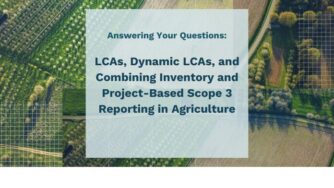The greenhouse effect is a natural phenomenon that insulates the Earth from the cold of space. The Earth’s greenhouse gases (GHGs) trap heat in the atmosphere and warm the planet. GHGs in the atmosphere help prevent this heat from escaping into space, instead of reflecting the energy back to further warm the surface. While this is vital to maintain life on our planet, too many greenhouse gases are becoming a key factor in global warming.
Why do greenhouse gases matter?
Margaret Kosmala, Senior Data Scientist at CIBO weights in:
“The important thing about greenhouse gases is that we need just the right amount of them in our atmosphere. In order for humans to survive on earth, we need a certain range of temperatures, which is controlled by these greenhouse gases. We need an even narrower range of temperatures to be comfortable and keep our civilization running the way we’re used to.”
“One thing that is greatly affected by earth’s temperature is the food we grow to feed ourselves. Not enough heat and crops grow too slowly to mature during the growing season; too much heat and the crops lose too much water and have trouble yielding. Different crops need different amounts of heat, which is part of why different crops are grown in different parts of the world. If the earth’s temperature heats up, then a crop that is traditionally grown in a specific place will no longer be growable there. This would create a great deal of disruption to world agriculture.”
“And, in fact, that is exactly what is happening today. The amount of greenhouse gases in the atmosphere is increasing and the earth is heating up. There are many consequences of this change in world temperature, including disrupted weather patterns, but the change isn’t the same everywhere. Farming is one of the first professions to feel the brunt of climate change, and farmers across the world are already noticing that the weather is dramatically different from the way it used to be.”
Find out more by reading her blog post: A Pocket Guide to Greenhouse Gases and Farming.
How can Regenerative Agriculture Help Reduce Greenhouse Gas Emissions?
At CIBO, we believe regenerative agriculture can be a key solution to helping reduce greenhouse gas emissions. Sustainable and regenerative agriculture has long been economically and environmentally aligned, but adoption has been slow.
Through the broad adoption of farm management practices that replenish the soil and help trap carbon in the ground, meaningful reductions in greenhouse gas emissions and improvements in soil-based carbon sequestration can be achieved. These practices promote long-term sustainability by increasing soil organic carbon, improving soil health and building farm resilience.
While the concepts are broadly understood, it has been difficult for farm owners and operators to easily measure the regenerative potential for their specific parcels of land.
How can CIBO help with Reducing Greenhouse Gas Emissions?
CIBO believes in helping each farmer connect with the land in a new way. That’s why we developed technologies that help enterprises and individual farmers reap the benefits of improving the environment.
CIBO enables companies to scale sustainability across their grower organizations by helping their grower-partners monetize regenerative practices through carbon markets and incentive programs. CIBO quantifies the carbon footprint of farmland under various management practices and verifies management practices from one field to an entire portfolio with cutting-edge, AI-driven computer vision. This enables farmers to discover their baseline greenhouse gas emissions and what they can do to improve carbon sequestration.
CIBO’s process distills data into actionable information enabling growers to take control and forge broad-scale sustainable paths for the entire food chain.
Want to see what other insights CIBO can bring? Try CIBO for free.



